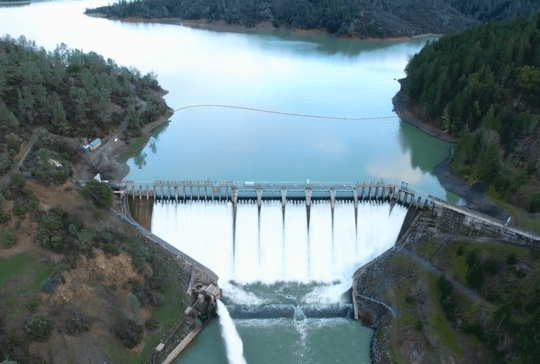Huge opportunity to remove largest dam on Eel River

Scott Dam on the Eel River (Photo by Mike Wier)
Earlier this month PG&E announced they are putting their Potter Valley Project out to open bid this fall. This project consists of two dams– Van Arsdale Dam that diverts water to the Russian River for hydropower and other uses, and Scott Dam, the only fish passage barrier on the mainstem Eel blocking over 150 miles of salmon and steelhead spawning and rearing habitat.
CalTrout, Friends of the Eel River, Trout Unlimited, and other conservation and commercial fishery interests have a goal to remove Scott Dam and return fish to the upper Eel watershed. Returning salmon and steelhead to their historic home in the headwaters of the Eel is a critical part of our efforts to restore fish abundance back to the Eel River.
What does PG&E’s decision to put the Potter Valley Project up to bid mean? It means that any entity could bid to buy the project and operate the facility for hydropower or just for the benefits of diverting water to the Russian River, or both as is currently the case. This is not our preferred alternative.
In an effort to push stakeholders towards dam removal, CalTrout has helped facilitate a series of ad hoc meetings convened by Congressman Jared Huffman (D-CA), which includes our conservation partners, PG&E, and Sonoma County Water Agency. Our hope is that through these conversations, the group of diverse interests can come to an agreement that includes the removal of Scott Dam.
Currently, CalTrout and partners are working to build the record of information to make the case for dam removal. To date we have established that there is at least 150 miles of spawning habitat above Scott Dam, we are working with a consultant to assess the feasibility and cost of removing Scott Dam, and we are in the process of assessing water rights.
Opportunities to remove big dams in California are few. Scott Dam on the Eel River represents one of the best opportunities in the state and PG&E’s announcement has helped move things along, hopefully in a positive direction for California’s salmon and steelhead.
To learn more about the Eel River and the opportunity for salmon and steelhead abundance once again, watch this film.





3 Comments
Please do what you can to remove the two dams that are in the way of river restoration and bringing salmon back to upper tributaries.
I am tired of hearing the lack of salmon being blamed on pot growers. It is true that pot growers lower the water table as do any agriculture endeavors. they do not compare to grapes and former crops of peaches, etc. I lived on Cave Creek for 30 years. Huge salmon came up that tiny creek. It was marvelous to see the amazing capacity for these fish, beaten to bits make it all the way to where tiny Cave Creek began. It is the logging tht has destroyed their habitat more than Anything. The logging industry filled the streams with silt so that the fish could not breathe. one day these magnificent animals came no more. Put the blame where it belongs: primarily on the logging industry and its shameful degradation of hillsides and watersheds. It continues today –
As a young lad in the early 50s I stayed on the Cahill ranch on Mill Creek by the dam and remember huge salmon coming up that wonderful little stream in the winter. The creek was full of smolts down low and held beautiful rainbows higher up on the mountain. I now live in Oregon and last year made a bucket list trip to the area. Mill Creek looked great but there was very little signs of smolts or rainbows. So sad. Totally support the dam’s removal and resurgence of upriver spawning habitat and small streams like Mill Creek.